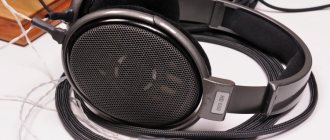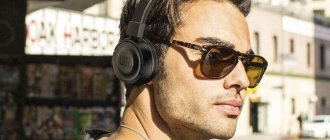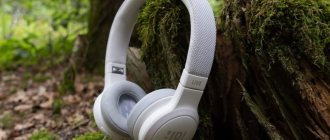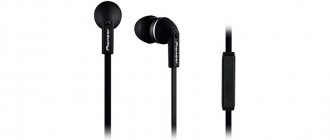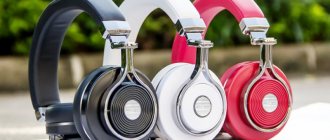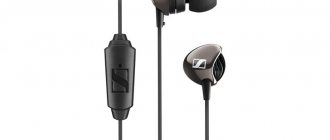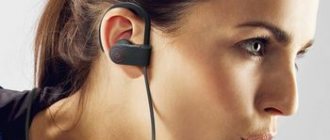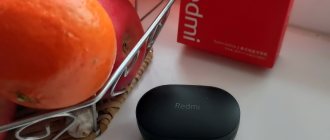Save and read later -
It doesn’t matter whether we are talking about inexpensive in-ear headphones for every day or professional studio monitors, ear pads are the second thing that determines sound quality after the speakers. The vast majority of beginners do not pay enough attention to this, as a result of which good headphones are declared uncomfortable or sound bad. Let's understand this unfair situation a little and find out how to use knowledge to squeeze out maximum comfort and quality.
Key moment
We have mentioned various types and designs of ear pads more than once when talking about the design of headphones in general and even tried to analyze them in detail. And all because this is really a very important thing. It is this part of the headphones that is in direct contact with the human body, and therefore is largely responsible for the feeling of comfort or discomfort. In addition, the ear pads actually form an acoustic chamber for which the headphone emitter operates. Well, the third factor that directly depends on them is the degree of suppression of external noise. Unless, of course, we are talking about open headphones.
Good ear pads provide reliable protection from external noise.
All this applies equally to both in-ear and full-size models. At first glance, their ear pads have nothing in common - they also differ tens of times in size. But from the point of view of the functions they perform, they are as close as possible.
Essence of the question:
For sound, ear pads are no less important than speakers.
Lifehack:
If you want to choose the right headphones, you can’t do without trying them on; you don’t buy clothes or shoes based on a picture.
Deep inside
The ear pads of in-ear models are, strictly speaking, a seal that fills and seals the gap between the earphone sound guide and the ear canal. An additional functional load is the fixation of the earphone in the ear, and this immediately makes us understand that we will have to look for some kind of compromise between convenience and reliability of the fit. You can choose those that fit very tightly, like a cork in a bottle, but how long can you walk with such earplugs? Comfort is equally important.
Ear pads are made from either silicone or foam. Conventional silicone ones can be divided into single-circuit, which, as a rule, have the shape of a hemisphere, and multi-circuit (they differ in the number of sealing contours and are designed for deeper immersion into the ear canal). If the high degree of intimacy when interacting with a piece of silicone does not bother you, try ear pads with two or three contours. Usually they provide the highest degree of sound insulation.
50 shades of black or adult games: choose the right ear pads for yourself.
For the most part, all silicone ear pads are similar to each other in terms of elasticity. Some are a little softer, others a little denser, but the main difference is not in softness, but in shape. If you look closely, the most common and widespread single-circuit ear pads have different shapes. One manufacturer makes them sharper and more elongated, another strives to give them a shape close to spherical, and a third makes their cross-section not round, but oval. The funny thing about this situation is that there is no universal form of ear pads and there cannot be. Anatomy is very individual: if oval ears are ideal for some ears, then others will definitely need round ones. Ideally, the delivery package for in-ear headphones should include ear pads of at least 2-3 different shapes. Manufacturers in most cases limit themselves to only one, presented in different sizes. Sad but true.
It is extremely important that the headphones provide the necessary noise isolation without causing discomfort.
In full-size headphones, the size of the ear pads is a given that cannot be changed. For in-channel ones, this is an additional factor that complicates the selection of a suitable pair. It is known that the shape of the ear pads is primarily responsible for comfort and the degree of isolation of external noise. The selection of size is determined by a much simpler factor - whether the ear pads will fit into the ear canal and whether they will sit tightly enough to perform their function in full.
Essence of the question:
In order for silicone ear pads to perform their function effectively, you need to choose the right shape and size. One does not exclude the other.
Lifehack:
Anatomy is a very specific thing and requires an individual approach; there is no need to rush. You'll have to try a lot of different ones before you find the ones that suit you.
Selection of ear pads
The occurrence of pain in the ear or frequent falling out of the earphone is most often caused by a banal discrepancy between the size of the ear pad and the diameter of the ear canal. In this case, the problem can be solved in a very trivial way: by replacing the ear pad with a suitable one.
First, let’s explain what this overseas word “embouchure”, which smells of coffee and croissants, means. This is the name for silicone, rubber or made of special foam material on headphones, designed to minimize the amount of third-party noise entering the auricle. That is why, when wearing so-called vacuum headphones, you can feel that all surrounding sounds seem to have become greatly muffled.
Important! Each person’s ear has its own shape and structural nuances, so when choosing ear pads it is important to take into account the size and depth of the auricle and ear canal.
Experts distinguish only three types of ear pads based on the size of the inlet and extender: small (5 and 7 mm, respectively), medium (5–9 mm) and large (5–11 mm).
Most headphones these days come with all three types of pads, so don't be afraid to experiment and change them (most often they can be easily removed by hand from the base of the earphone). Once you find the diameter that suits you, problems with earbuds falling out or low frequencies not being reproduced deeply enough should disappear.
As for the choice of ear pad material, products made from special foam material have recently become increasingly popular. The well-deserved second place of this improvised top is occupied by silicone pads. The most discomfort (especially if the size is chosen incorrectly) is usually caused by rubber “plugs”.
Something special
In addition to size and shape, single-circuit ear pads may also differ in design. They usually consist of two parts: a tube that fits onto the sound guide, and a sealing skirt. The space between these two parts, as a rule, is not filled with anything.
Some manufacturers complicate the design of conventional silicone ear tips.
However, some manufacturers complicate the design by casting additional jumpers in this space or filling it with special materials. This increases the elasticity of the ear pads, makes the fit tighter, and can improve noise isolation if they are the right size and shape. And of course, there will always be those for whom such ear pads are absolutely not suitable, because they are denser than usual.
Essence of the question:
Silicone ear pads can be anything but simple.
Lifehack:
Modified ear pads are rarely found on the market. As a rule, they are included with expensive headphone models.
Lots of foam
An alternative to silicone ear pads is foam ear pads. This is a significantly more expensive material, but it also provides a wider range of possibilities. By changing the characteristics of the foam, manufacturers can achieve either the highest noise insulation or the opposite effect - good fixation in the ear with the ability to hear surrounding sounds. The shapes of foam ear pads also come in different shapes. Mostly spherical or truncated cone predominate. Size also matters. The foam used in most cases is heat-sensitive and memory foam. When heated by body heat, they become softer, and after compression they gradually return to their previous shape. This increases the degree of physical wearing comfort. Although some people find any foam ear pads uncomfortable due to specific tactile sensations.
The choice of foam ear pads is truly rich in size, shape, and degree of insulation of external noise.
But what is absolutely objective and indisputable is their higher cost. A set of foam ear pads costs significantly more than a similar set of silicone ear pads. However, foam ear pads are not durable and require regular replacement. Porous material gets dirty more easily and quickly, and it is very difficult to wash, clean and disinfect it without damaging it. Over time, the foam begins to crumble and becomes unusable. In short, the love for foam attachments becomes an additional expense.
Essence of the question:
Pleasure cannot be cheap. You have to pay for comfort.
Lifehack:
Wholesale is cheaper. Decide on your favorite model of ear pads and buy them in packs of several pairs.
Ear pads for headphones. Effect on sound - myth or truth? Choosing nozzles
It's time to honestly discuss the topic of ear pads for in-ear and full-size headphones. Even if the manufacturer initially provided a generous set of accessories for the model, it is this type of accessories that most often requires replacement. Ear pads get lost, deteriorate, break, or just get boring. Therefore, for an audiophile, a personal collection of attachments is just a matter of profit. Unfortunately, there are many misconceptions about their properties. Let's talk briefly about this today.
How to choose nozzles
The importance of attachments cannot be underestimated. In fact, this is the thing that is always located between the earphone and your ear. Accordingly, ear pads can transmit sound purely, or they can completely ruin it.
The problem is that there are no bad ear pads. Their selection is very dependent on your anatomy, the features of a particular headphone model, the size of the sound duct and the nature of the sound. And if a pair of attachments does not suit you, there is a very high probability that it will fit perfectly for some person. Or you yourself will appreciate it over time, but on other headphones. This is why audiophiles often collect a large collection of a wide variety of attachments with which they listen to their equipment.
Naturally, I don’t mean nameless ear pads for three kopecks, made of strange rubber or dubious foam and sold by the handful by the weight. There you will find nothing but primitive performance, poor sound impact and zero longevity.
I’ll tell you a little more about the features
Let's start with in-ear headphones. When choosing, what matters is the material from which the nozzles are made, their shape, density, core thickness and “skirt” width. The nozzles should fit well onto the sound guide, coincide with it in length, and not overlap the crossover. Of course, they can’t fly off on their own. But more importantly, they must be the right size for you. When you wear headphones with properly selected ear pads, you get comfort and excellent noise isolation. Also, under this condition, there will be maximum output at low frequencies, a completely harmonious musical picture. A typical indicator that the eartips are not selected correctly is when the headphones make a suspiciously thin squeak. On the other hand, ear pads that are too large can drown out not only external noise, but also the detail of the sound.
In this case, I repeat, much depends on the structure of the headphone housings and the length of the sound guide. In some cases, medium-sized nozzles are too large, in others they are too small.
By the way, knowing the effect of tips on the sound, you can largely tune the headphone output, adjusting it to your preferences.
Now let's talk about overhead and full-size models. Here convenience comes first. The quality of the material, shape and filling of the pads should improve ergonomics as much as possible. Also, the fabric from which the pads are made is not always acoustically transparent. Therefore, when choosing replacement ear pads, it is better not to save money.
Again I note the role of sound insulation. If you use headphones on the road or in a noisy room, the ear pads should cover your ear well. This will give a full scale of the scene, correct positioning of imaginary instruments and balance between all frequency spectra. Even headphones with active noise cancellation won't do their job if they don't fit well.
To conclude this section, I will add that all attachments do not last forever, and this is normal. If you are new to audiophilia, rest assured that old and worn ear pads can and should be thrown away. Now there is a huge range of interesting options for purchase, from budget to very premium, and this is not so much entertainment as it is a necessity. Firstly, brands are improving the technology of nozzle production, improving their acoustic properties and comfort. Secondly, regularly replacing ear pads is good for your health.
Types of headphone tips
Let's start again with the ear pads for the in-ear headphones. Based on the type of material they are divided into three categories:
1. Silicone
These are the most common attachments. Even very cheap models usually come with several pairs of rubber bands. And headphones from the top segment are most often accompanied by a real abundance of silicone ear pads for every taste. They may differ in both size and design. Traditionally, differences in the effect on sound are indicated using color, but sometimes there are labels, for example, “for vocals”, “for bass” and so on.
There are both standard single-flange and double-flange, and even three-flange ear pads called herringbone ear pads. If you like a deep fit, check them out.
In some cases, branded ear pads can have a fairly high price, since they are produced using special technologies and are of the highest quality. These include tips from Final Audio, which have a durable, textured core, as well as the famous SpinFit, which can adapt to any shape of the ear canal thanks to its movable head. By the way, as for the latter, I personally have been using them almost exclusively for several years; their cost is absolutely justified.
2. Foam
The second popular type of nozzles. They are mainly valued for their versatility and convenience. There are headphones that some people use only with foam. We also get excellent noise insulation, and our ears won’t get too hot. The disadvantages are fragility, and also a specific effect on the sound, which not everyone likes. Here a lot depends on the quality of the foam.
3. Hybrid
The rarest type of ear pads, but, nevertheless, already well proven. It is a combination of silicone and foam; this solution extends the life of the nozzles, while remaining comfortable and versatile. The sound style here is also specific, but I can call it quite pleasant. In general, these ear pads are ideal for a noisy city.
Let's go to full sizes
The material from which the earpads for such headphones are made varies greatly. There is leatherette, special breathable sports fabric, velor, genuine leather, and Alcantara. The better the quality of the ear pads, the better your experience will be when using the over-ear model. The type of fabric, thickness and presence of perforations can greatly change the sound. I personally recommend choosing velor, it is tactile and acoustically good, but you may have completely different preferences.
Not only foam rubber is now used as padding for pads, but also special memory foam. It's damn convenient.
It is important to consider whether the ear pads are compatible with your specific headphone model. It is, of course, easier to choose rubber bands for the inner channels. But tips for in-ear headphones regularly try to get lost, and are generally less durable than expensive, high-quality ear pads for full-size headphones.
Identical in appearance
Whatever type of ear pads you choose, it’s worth remembering: you need to combine them not only with the size and shape of your own ear canals, but also with the size of the sound tube of the headphones. While similar in appearance, they may differ in diameter, as a result of which the ear pads from some headphones may not fit onto the sound guide of others or may sit too loosely. There is no single solution to this problem.
Will the size fit or not?
You won't know until you try. Compatibility is guaranteed only with standard ear pads. Most headphone manufacturers make sound guides of approximately the same diameter, but there are overly thin or, on the contrary, very large specimens that require special ear pads.
Essence of the question:
The interchangeability of ear pads is relative, although they all look similar. The ear pads of one headphone will not necessarily fit another.
Lifehack:
If you are not sure that the ear pads fit securely on the sound duct of the headphone, refrain from using it and find more suitable ones.
Private bussiness
Separately, it is worth mentioning the so-called “custom” (from the English Custom - made to order). These are headphones whose ear pads are a mold of the inside of the user's ear. Provided that it is manufactured correctly and high-quality materials are used, the noise insulation, as well as the degree of comfort, is ideal. The only problem is that you can’t give these headphones to a friend to listen to. This is a purely individual thing.
Custom headphones can look very nice.
At least from the outside. And making custom headphones is an expensive proposition. The good news is that they are durable and are actually a one-time investment. Unless, of course, the first instance of custom suited you in all respects and you didn’t have to go down the crooked path of finding the best.
Essence of the question:
Custom headphones can be the ideal solution, but they will cost more than the best and richest set of tips.
Lifehack:
When ordering custom headphones, you should also think about their design. Even if the inside looks like used chewing gum, the outside of the custom can be decorated.
Don't be soft
The design of the ear pads of headphones with a headband has nothing in common with the ear pads of in-ear headphones, but they perform the same functions. Fitting tightly to the surface of the auricle or to the head around the ear, they muffle external noise, creating conditions for the speakers to operate effectively.
Various types of foam are used as filling, sometimes with memory effect. For over-ear headphones adjacent to the surface of the auricle, the foam material is preferably soft. Large ear pads that cover the ears around and adjacent to the head are usually filled with denser material to better hold their shape.
When looking for the softest and most luxurious ear pads, the main thing is not to overdo it.
Do not forget that softness should have its reasonable limit. Some ear pads are so soft that you can feel the earcup itself with your body, from which they should, in fact, provide isolation. It feels like you're walking on coarse gravel in sneakers. Your feet don’t seem to be bare, but you can feel every pebble.
In addition, the ear pads of most headphones are heat-sensitive to one degree or another: those that initially seem hard can soften under the influence of body heat to a comfortable state after a couple of minutes of wearing. What will happen to the ear pads, which were soft even without heating? Well, you already understood everything yourself.
Essence of the question:
Soft ear pads are nice, especially when it comes to over-ear headphones, but the main thing is not to overdo it with softness.
Lifehack:
Before you look for headphones with the softest ear pads, make sure that they will not stop protecting your ears from the pressure of the earcups once they warm up to body temperature.
Ear pads and headphone tips
Today we’ll talk about one of the key parts of any headphones – the ear pads. And here it is no longer so important what kind of headphones we are talking about: professional and expensive ones, or budget options. Indeed, in any case, the ear pads are the second thing on which the final sound depends. Many lovers of good music do not pay attention to this aspect, which is why even expensive and professional headphones do not sound good enough. In this regard, let's talk a little about attachments and ear pads, and try to figure out how to improve the sound quality of even the cheapest models.
The ear pads of classic on-ear headphones are a soft inner part that fits tightly to the head. But if we are talking about “earbuds” and in-ear models, then this is an attachment that goes into the ear canal. In this version, not only the sound quality, but also the convenience for the listener depends on the ear pads. This is very important, especially when listening to music for a long time, because even with the highest sound quality, comfort plays a key role, as does noise reduction. Sound is a very subtle matter, which is influenced by absolutely everything it comes into contact with. So the leading violin in this matter is played by the materials from which the nozzle is made, and only then by the form.
Nozzles for in-canal models
Let's highlight the key types of nozzles:
— Perhaps the most widespread are the usual single-flange ear pads, with a hard core and soft petals. Most headphones come with replacement ear pads in several sizes, which allows you to choose the most suitable option.
— They are inferior in popularity to three-flange “Christmas trees.” Yes, they retain a solid core, but thanks to the petals of different diameters, you can place the earbuds most tightly and comfortably in the auricle. But yes, this type of attachment is not suitable for everyone. The main advantage is maximum noise reduction, which allows you to fully enjoy your favorite music.
— Various designer ear pads. Could there be anything better than a custom earpiece designed taking into account the specific structure of the ear canal? Here you can immediately forget about any extraneous noise. Just a couple of years ago, such attachments could only be seen on musicians, but over time, more and more music lovers began to purchase custom ear pads.
Materials used for the production of in-ear ear pads
Silicone . Definitely the most accessible and least loved material by many musicians. The problem is that silicone does not allow air to pass through, which is why your ears begin to sweat from prolonged wear. The material also allows quite a lot of extraneous noise to pass through, being inferior in this indicator to polyurethane. If we forget about convenience and talk purely about musical performance, then silicone tips cut off part of the range. Of course, a lot depends on the quality of the source material. There are many serious companies that produce their headphones with silicone tips. There are also obvious advantages - durability and ease of maintenance.
Polyurethane . For the first time, such ear pads appeared in the 90s and immediately made a real revolution, which was influenced by the parameters of this material. The whole point is the elasticity and viscosity of polyurethane; moreover, it is quite durable, which is why it is considered most suitable for making ear pads that perfectly follow the geometry of the ear canal.
Acrylic . The most expensive solution. 99% of all custom headphones are made from acrylic. The material is able to perfectly replicate the structure of the ear canal. And most importantly, it is absolutely neutral in sound terms.
Over-ear headphone covers
Of course, in-ear headphones are seriously inferior to classic on-ear headphones, especially in terms of long and comfortable listening to music. Full-size headphones fit comfortably around your head and do not strain your ears, which is very important. If we talk about ergonomic issues, then they are seriously inferior, although there are folding models.
But still, on-ear headphones have a wider selection of materials for creating ear pads. Let's look at the most popular:
— Leather is one of the most expensive options used in premium headphones. Thanks to perforation, it was possible to solve the problem of sweating when wearing headphones in hot weather. If we talk about sound, then the skin has a very good effect on it, especially when it comes to the low-frequency range.
— Eco-leather . Simply put, this is artificial leather, which is almost as good as real leather in its parameters, but seriously reduces the cost of the headphones themselves. High-quality eco-leather is also a breathable material. But again, it all depends on the quality. If the artificial leather is of poor quality, then this completely negates all the advantages. For example, if you wear headphones in cold weather, even slight frosts, they will begin to crack, and in summer your ears may sweat. But still, reputable companies producing headphones give preference to high-quality eco-leather, so music lovers do not encounter such problems.
— Velor is definitely the best material when it comes to ergonomics. The material has excellent tactile and sound-absorbing qualities. If we talk about disadvantages, velor is easy to get dirty, and it wears out quite quickly.
— Microfiber and fabric are the best “breathable” materials. Typically, microfiber is used to create pads for the cheapest headphones. But still, this is a very good solution, since the fabric does not affect the sound quality. And its fragility is fully compensated by its low cost.
- Foam rubber . Everyone is gradually moving away from this material, since now there are enough different analogues, the parameters of which are much higher. Rarely found on the cheapest headphones.
In addition to the material of manufacture, it is worth paying attention to the filler, because the nature of the sound directly depends on it. Modern manufacturers are trying to find the ideal balance between material density and ergonomics. The sound in the low-frequency range also depends on density.
So, we’ve sorted out a little about the ear pads of the headphones, now let’s talk about the factors that you should pay attention to when choosing the right model:
— Softness – when listening to music for a long time, comfort is extremely important.
— The depth of the pads - the distance from the cup to the edge greatly affects the sound. Long distances have a negative impact on sound quality.
— Size – be sure to try on the headphones before you buy them. It is important to find a model with a comfortable fit.
RESULT
Most often, we consider headphones only as a means of playing our favorite songs, and we focus on sound quality. The goal of this material is to talk about headphones from the reverse side and stop considering them solely as “speakers for the ears”; they are a full-fledged accessory. In this regard, the choice of headphones must be approached with the utmost seriousness. The correct choice of ear pads affects not only noise insulation, but also the final sound. Feel free to try on headphones, compare them with other models not only in terms of sound quality, but also because of how comfortable you are in them. This is the only way to choose the perfect headphones that will give you unforgettable pleasure from listening to your favorite music.
BUY HEADPHONES AND ACCESSORIES
Leather, but not crocodile
The choice of exterior finishes is quite wide. The best option (in terms of comfort and noise insulation) is considered to be genuine leather. But quality faux leather can be just as good in terms of wearing feel and durability. And it is no longer possible to distinguish good artificial leather from natural leather. Currently, the vast majority of manufacturers use high quality artificial leather. Good leather ear pads, regardless of the origin of the material, are pleasant to the body and cause a greenhouse effect only when worn for a long time in the warm season. To eliminate the latter, some manufacturers perforate the leather of the ear pads, which not only provides natural ventilation, but also reduces the degree of noise insulation.
In their older models, Focal implemented the most comfortable ear pad options - soft leather with perforations and fabric.
Low-quality leather substitutes are stiffer and less comfortable to the touch, and may have folds that reduce the degree of insulation from external noise. The cheapest artificial leather can be soft, but it rustles unpleasantly when in contact with the body. However, a price alternative to such a finish can only be considered bare polyurethane foam or, more simply put, foam rubber. By the way, it is also not particularly comfortable and rustles when you touch the body.
The second most common material is velor or velvet. In terms of tactile sensations and performance properties, artificial suede Alcantara is close to them. Acoustically transparent fabric is used less frequently, most often in over-ear headphones, in which the ear pads are shaped like a solid pillow. All these materials are more pleasant and comfortable during prolonged use, and have better breathability than leather. No wonder velvet and velor are often used on professional models. On the other hand, there are also disadvantages: a slightly lower degree of noise insulation, difficulty in maintenance (the skin is much easier to clean).
On the left are standard ear pads for Sony studio headphones - an unpleasant rustling material and an uncomfortable shape, on the right - a much more comfortable alternative made of high-quality artificial leather.
There are also more exotic versions of ear pads, for example, silicone. But such models, for obvious reasons, did not become popular. They are hot in summer and cold in winter. It's just convenient to wash. There are no other advantages.
Essence of the question:
The finish determines the degree of comfort. It is not the naturalness that is important, but the quality of the materials.
Lifehack:
If you like some specific headphones, but don’t like the standard ear pads, remember: in many models they can be replaced (including non-original ones of higher quality).
How to choose ear pads for headphones?
What is the most important thing when choosing headphones? Sound quality? Price? Well-known manufacturer? No, the main thing is that the suit headphones fit comfortably in your ear. Because if it rubs in the ear canal, the ears sweat, or any discomfort is felt, there is no time for music. And it is the ear pads that ensure comfortable use of the headphones.
Just a few years ago, it was believed that ear pads were just soft cushions on the speakers of full-size headphones. But now this word refers to any attachment on headphones that is directly adjacent to the ears or ear canal. Ear pads are needed to:
- It was convenient to wear headphones;
- absorb external noise.
The tips are different for each type of headphone. And they differ not only in shape, but also in material.
Ear pads for over-ear headphones
According to the shape of the tips for full-size headphones, there are: circum-aural (completely enveloping the ear) and supra-aural (over-ear). The shape affects the quality of noise insulation; in over-ear headphones, extraneous noise will be heard more clearly than in wrap-around ones.
The wearing comfort is affected by the material used to make the ear pads. There are three possible options here.
- Leather or high-quality leatherette
Expensive headphone models, such as full-size Partner Desire headphones, can boast of natural leather ear pads. This material has many advantages: genuine leather does not wear out for a long time, filters out extraneous noise remarkably well and looks solid. However, in every ointment there is a fly in the ointment: if you wear headphones with leather ear pads for several hours, your ears will sweat.
Ear pads made from high-quality leatherette (for example, PU leather) have the same pros and cons as models made from natural material, but headphones with them are much cheaper.
- Textile
Fabric ear pads feel softer on the ears and do not turn into a steam room after a couple of hours. However, the fabric gets dirty quite quickly and, of course, insulates external sounds worse.
- Leatherette
This is the cheapest and least preferred option. The only advantage of leatherette ear pads is the price. But they will serve just as little: dermatin quickly wears out and crumbles, and in addition can cause irritation of the scalp.
Ear pads for in-ear headphones
They are approximately the same in shape, but the material is of fundamental importance.
- Silicone
Silicone ear pads are the most common. Partner Style in-ear headphones are equipped with three replaceable silicone tips of different sizes. They are comfortable, hygienic and gently adapt to the individual anatomical features of a person. Silicone tips are quite durable.
- Foam
Nozzles made of special porous material, foam ear pads, this is the same sponge. Some music lovers claim that such material provides better sound. But in fact, foam tips need to be changed frequently due to the fact that they become clogged with earwax. Approximately once every 4-5 months.
Summary
To choose headphones with comfortable ear pads, pay attention to the material of the tips and the type of headphones themselves. For full-size models, ear pads made of genuine leather or PU leather are optimal; for in-ear ones - silicone ear pads.
Go to the "Headphones" section
Round or flat?
In addition to materials, size and shape are important. The difference between invoices and covering ones is generally clear. Over-ear headphones press the auricle to the body and, given certain structural features of the latter, this can cause discomfort during prolonged use. The shape of the ear pads is not of fundamental importance. Their task is to cover the central part of the auricle.
There are exceptions when the pressing force is not great, and the ear pads are small in size, as a result of which they rest only on the central part of the auricle with little force. An excellent illustration of this is the well-known Koss Porta Pro and modern models created according to the same principle.
Even rectangular ear pads on over-ear headphones can be comfortable if their ergonomics are well thought out.
Large, enveloping ear pads are more comfortable in the sense that they do not press the ears to the head, but are located around them. The price of this is the significantly larger dimensions and weight of the headphones themselves.
There are some nuances. For example, you should pay attention to the shape of the ear pads. The most comfortable is the elongated one, which generally follows the shape of the ears. Large round ear pads with a constant thickness may not fit tightly at the edges (usually in the back of the head), because the head does not have such an extensive flat surface. And in round ear pads that are not large enough, the ears may not fit entirely.
Large round headphones should have fluffy asymmetrical ear pads that will ensure a tight fit around the entire perimeter of the head.
An important factor is the cross-section profile of the ear pads. Most often, the foam roller that fills the ear pad has a circular cross-section, which gives a relatively small contact area with the body. In addition, radial folds may form on the leather surrounding the round ear pads.
The cross-section of the ear pads determines how comfortably they will fit on your ears or head.
Rectangular ear pads behave much better. They are more expensive to manufacture, since a round cushion can be covered with one strip of leather or fabric, and ear pads with a rectangular cross-section are sewn together from at least three parts. But the advantages are very significant. The flat surface of contact with the body provides better noise insulation and more evenly and comfortably distributes the compressive force created by the headband of the headphones.
Essence of the question:
And again you need to try on and choose the right headphones for yourself, but how else?
Lifehack:
If dimensions don’t bother you, choose headphones with wrap-around ear pads. For indoor use this is the best option. Choose over-ear headphones that are more suitable for wearing outdoors with ear pads that have a flat surface.
How to choose ear pads for headphones by size?
To select ear pads for in-ear models, first check the complete products. For example, Apple AirPods Pro contains a set of three pairs. Products selected to fit create a feeling of “vacuum” in the ear hole and do not fall out.
The ear pads for in-ear headphones need to stay in place in your ears. These models are available in one size.
The ear pads should gently press the ears, not squeeze, otherwise, choose other models.
It is easier to select full-size products: the ear should be “inside” the device.
The size is chosen not only by sensations. While wearing headphones, you should shake your head. The in-ear ones don’t “jump out” and the “cymbals” don’t move off the head.
What to look for when choosing ear pads?
To make sure that the products are suitable, you need to stay in the headphones for at least 7 minutes. During this time, the silicone will become softer due to natural heating and the degree of comfort is assessed objectively. This rule applies to every device, including the world's smallest wireless devices from Dot.
Products should slowly return to their original configuration when pressed. To check, the nozzle must be squeezed firmly and released. Rapid leveling indicates an uncomfortable degree of elasticity of the material. The golden mean is Spiral Ea's handmade products, which use soft medical grade silicone.
They select not only the appropriate diameter, but also pay attention to the distance from the cup to the edge of the ear pad. The larger it is, the worse the sound will be.
Athletes choose models with clamps. Reliable mounts like Samsung EO-EG920L. For swimming, it is advisable to select a waterproof rubber design.
A universal solution is round ear pads. For those with large and elongated ears, oval on-ear devices, such as the Sennheiser HD 280 Pro, are suitable.
